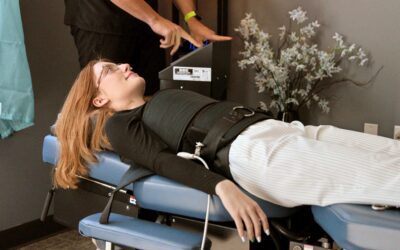Have you ever stopped quickly and felt your neck snap forward? You might have suffered whiplash, which happens when your head suddenly and forcefully moves back and forth, causing strain to the muscles, ligaments, and vertebrae in the neck.
Most often associated with car accidents, whiplash can also result from sports injuries or other high-impact events. It’s also possible to suffer whiplash on roller coasters because of the jerky movements and quick starts and stops.
You even need to be careful tubing behind boats. Those quick turns and spills into the lake can be a serious pain in the neck.
This rapid movement stretches and tears the soft tissues (muscles, ligaments, and tendons) in the neck, causing pain and discomfort. Whiplash can also cause misalignments in the cervical spine, which may lead to further complications if left untreated.
Common Whiplash Symptoms
Keep in mind that your whiplash symptoms may take 12 hours or even up to a few days to appear, so be careful in the first few days after an injury even if symptoms are mild. They could change.
You may also have symptoms in the neck that radiate elsewhere in your body, like your shoulders. Other muscles may also tighten up to try to protect you. Symptoms depend on the grade of injury and commonly include the following:
- Neck pain and stiffness
- Decreased range of motion in the neck
- Headaches, often starting at the base of the skull
- Fatigue
- Dizziness
- Blurred vision
- Irritability
- Sleep disturbances
If you suspect you’ve suffered a whiplash injury, it’s essential to consult with a healthcare professional to obtain a proper diagnosis and initiate appropriate treatment.
Grading the Severity
The severity of whiplash can vary significantly, with some individuals experiencing only mild discomfort, while others may endure debilitating pain and restricted mobility. To better classify the wide range of symptoms, whiplash is often categorized into different grade levels.
Grade 1: Neck complaint like stiffness, soreness, or tenderness, but no physical sign of injury on the neck.
Grade 2: Symptoms from grade 1 and musculoskeletal signs like tenderness or restricted range of motion. You may have radiating pain, spasms, or stiffness.
Grade 3: Symptoms from grades 1 and 2 and neurological issues like pins and needles, inability to feel hot or cold, vision problems, dizziness, weakness, or even hoarseness, as well as headaches.
Grade 4: Neck complaint and fracture or dislocation.
You may also experience nausea. Whiplash can accompany head injuries such as concussions, so it is important to seek medical advice if you’ve had a sudden-impact injury.
Diagnosis
A chiropractor will ask you to perform simple movements to test your range of motion and pinpoint pain. X-Rays, MRIs, and CT scans can’t show whiplash, but your doctor might order them to eliminate other sources of pain.
How Chiropractic Care Can Help with Whiplash
Milder cases of whiplash are typically treated by applying icepacks for the first week or so, then heating pads. You will want to move your neck gently as soon as you can so that your muscles don’t tighten up.
But for more severe cases, chiropractic care is an effective, natural, non-invasive approach to treating whiplash injuries. Chiropractors specialize in addressing musculoskeletal issues, including those affecting the spine. Some of the ways chiropractic care can help with whiplash include:
Spinal Manipulation: Whiplash can affect your spine due to impact and/or because injured muscles can cause your spine to become misaligned. Chiropractors can help realign the cervical spine and restore proper joint function. This can alleviate pain, reduce inflammation, and improve overall spinal health.
Soft Tissue Therapy: Chiropractors can use various soft tissue techniques such as Electric Muscle Stimulation to relax tight muscles, release muscle knots, stimulate the nerves and improve circulation. This can help reduce muscle spasms and pain associated with whiplash injuries. You may also try massage or cupping treatments to increase blood flow to the injury.
Therapeutic Exercises: Chiropractors can prescribe specific therapeutic exercises to help restore strength, flexibility, and range of motion in the neck. You may need physical therapy to increase your range of motion. These exercises can also aid in preventing future injuries.
Lifestyle Recommendations: Chiropractors can offer advice on ergonomics, posture, and other lifestyle factors that can help promote a healthy spine and reduce the risk of further injury.
Coordinated Care: If necessary, chiropractors can work in conjunction with other healthcare professionals, such as physical therapists or massage therapists, to provide a comprehensive treatment plan tailored to each patient’s unique needs.
We’re Here To Help
Chiropractic care is a safe and effective treatment option for whiplash, and can help patients find relief and regain their mobility. If you have been in a car accident and are experiencing any of these whiplash symptoms, it is important to seek medical attention as soon as possible.
Your chiropractor can work with you to develop a treatment plan that meets your individual needs and helps you get back to your normal life as quickly as possible.
If you’re suffering from a painful whiplash injury, we can help relieve your symptoms naturally. Contact us to schedule an appointment.


